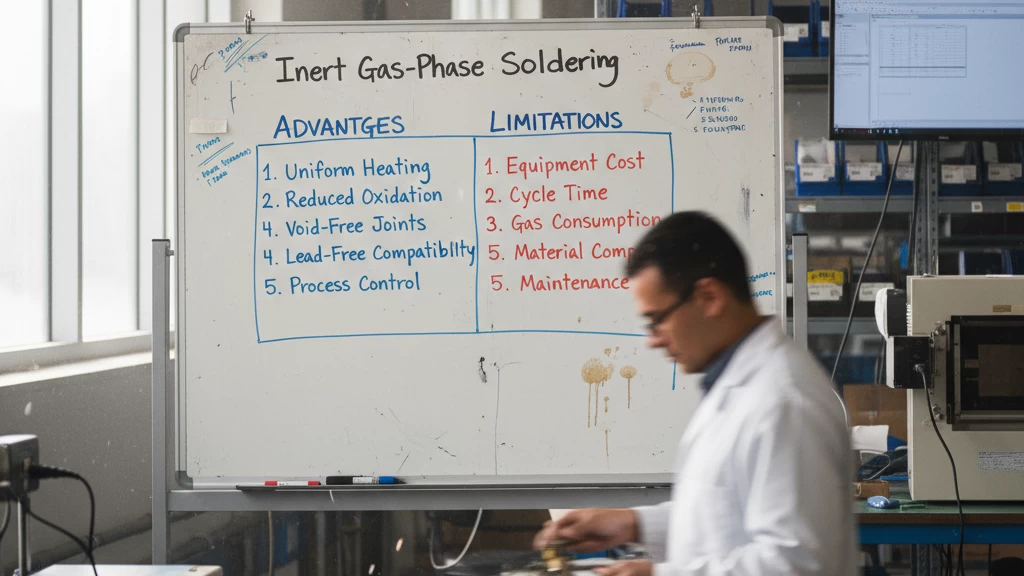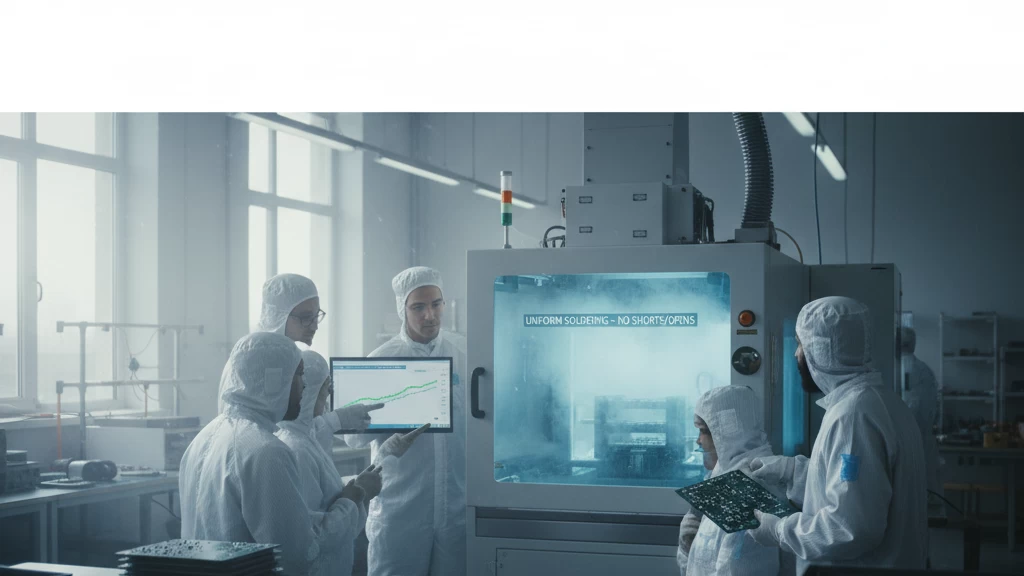The rising costs of nitrogen in reflow soldering combined with ongoing oxidation defects continue to challenge PCB assembly lines. Traditional nitrogen protection methods, while effective, are becoming less sustainable and more expensive due to supply and maintenance demands.
Gas-phase soldering offers a game-changing alternative—an oxygen-free process that uses inert vapor condensation to create a clean, controlled environment. This method not only cuts costs significantly but also ensures superior solder joint quality by eliminating oxidation at the source.
At Jeenoce, we specialize in seamless SMT line integration that bridges the gap between conventional reflow ovens and cutting-edge vapor-phase soldering systems. Our scalable automation solutions empower manufacturers to adopt this innovative technology with ease, driving both efficiency and quality improvements in today’s competitive electronics market.
Reflow soldering in surface-mount technology (SMT) follows a set process: preheating the board, activating flux, reflowing the solder paste, and then cooling down. Each stage is critical to ensure reliable solder joints on printed circuit boards (PCBs).
Nitrogen plays a key role here by displacing oxygen in the oven atmosphere to below 100 parts per million (PPM). This low-oxygen environment stops oxide layers from forming on pads, component leads, and molten solder. The result? Better solder wettability, fewer voids inside joints, and a notable improvement in overall assembly quality.
In practice, nitrogen use can reduce soldering defects by 10-20%, especially in dense, fine-pitch boards. However, achieving this requires ultra-high purity nitrogen (99.99%), which can cost anywhere from $0.50 to $2 per board in gas expenses alone.
The downside is significant. Nitrogen supply chains can be unstable, causing production pauses. Plus, investing in nitrogen generators runs over $25.000 upfront, with ongoing maintenance and energy costs due to the need for constant purging during operation. These overheads add up quickly, creating a real cost burden for many manufacturers aiming for top-tier PCB assembly quality.

Relying on nitrogen gas in soldering comes with some real drawbacks for all electronics makers today.
High costs: For mid-volume SMT lines, yearly nitrogen expenses often top $50.000. On top of that, downtime from swapping out cylinders cuts into productivity and adds hidden costs.
Quality issues: Even small spikes in residual oxygen during nitrogen purging can cause dross buildup up to 10 times more than ideal. This leads to solder bridging and defects, especially with fine-pitch components where precision matters most.
Environmental impact: Producing and transporting ultra-pure nitrogen means a sizable carbon footprint. Plus, nitrogen systems can be tricky to scale or adapt when dealing with varied PCB designs and automation setups common in diverse U.S. manufacturing environments.
Industry experience: Some U.S. electronics firms report rework rates near 15% linked directly to inconsistent nitrogen supply and quality, pushing up costs and delaying shipments.
These limitations underline why many are exploring gas-phase soldering as a more reliable and cost-effective alternative.

Gas-phase soldering uses vaporized inert fluids like Galden PFPE to create an oxygen-free environment, protecting your PCBs from oxidation without the need for nitrogen. Here’s how it works:
Vaporization: The Galden fluid heats to its boiling point (around 230°C for Sn-Ag solder), producing a dense, oxygen-free vapor blanket.
Closed Chamber: Soldering happens inside a sealed oven where the vapor condenses uniformly on boards, transferring heat efficiently.
Stable Temperature: This condensation delivers steady heat with rates from 100 to 400 W/m²K, avoiding hotspots and ensuring precise profiles.
No Gas Flow Needed: Unlike nitrogen reflow, this method doesn’t require continuous gas purging. The fluid’s nature keeps oxygen below 1 PPM, eliminating oxidation risks naturally.
| Feature | Gas-Phase Soldering | Nitrogen Soldering |
|---|---|---|
| Oxygen Level | < 1 PPM (inherent inertness) | < 100 PPM (requires gas flow) |
| Heat Transfer | Latent heat via condensation | Convective heat transfer |
| Gas Supply | None (closed-loop fluid) | Continuous nitrogen supply needed |
| Hotspot Risk | Self-limiting temperature | Possible with uneven flow |
Jeenoce brings customized vapor-phase soldering modules designed for modern SMT lines, supporting up to 5.000 boards per hour. Our solutions help manufacturers transition smoothly to gas-phase soldering while maintaining throughput and quality.
Gas-phase soldering is changing the game by cutting costs and boosting reliability in oxygen-free soldering environments — a real shift from traditional nitrogen methods for manufacturers in East and Southeast Asia focused on quality and efficiency.
Switching from nitrogen to gas-phase soldering can bring big benefits across cost, quality, efficiency, and sustainability:
Cut soldering expenses by 40-60% by eliminating nitrogen gas purchases.
Use 80% less energy compared to traditional convection ovens, thanks to efficient heat transfer through inert fluid condensation.
Reduce flux consumption, which saves money and lowers waste.
Achieve zero oxidation defects since the process is fully oxygen-free.
Get 100% uniform wetting, even on complex and fine-pitch components, improving joint integrity.
Produce stronger solder joints with fewer voids and better thermal cycle performance that meets or exceeds IPC standards.
Speed up cycle times by 20-30% with faster, more consistent temperature ramp-up.
Enjoy a wider process window ideal for lead-free solder alloys, making it easier to switch materials without quality loss.
Generate less dross, which means cleaner post-soldering processes and less rework.
Use closed-loop fluid recycling to minimize waste and operating costs.
Produce zero hazardous emissions during soldering, improving workplace safety and environmental impact.
Comply easily with RoHS and REACH regulations without relying on nitrogen, cutting your overall carbon footprint.
By moving to gas-phase soldering, manufacturers in East and Southeast Asia can reduce operating costs, improve quality, and strengthen sustainability efforts—making it a smart choice for competitive SMT production today.
Gas-phase soldering uses inert condensation to deliver an oxygen-free environment, cutting oxidation defects and boosting solder quality. Here’s a closer look at what makes it work:
Condensation beats convection: Condensation heat transfer rates reach 100-400 W/m²K, far better than typical convection ovens.
Even heating: This ensures uniform temperature ramps and smooth solder flow, crucial for heavy parts like BGAs and fine-pitch components.
Stable and safe: Galden PFPE is non-toxic, non-flammable, and stays effective for over 1.000 cycles.
No-clean flux compatible: Works seamlessly with modern fluxes, reducing residues and cleaning steps.
Reusable: Closed-loop recovery means it’s sustainable and lowers operating costs.
No shadowing: Vapor surrounds every part evenly, eliminating cold spots where oxidation can form.
Multi-zone control: Precise temperature and oxygen level adjustment across chambers keep boards protected throughout.
Real-time monitoring: Sensors track O₂ levels (usually <1 PPM) and temperature for consistent process control.
| Metric | Nitrogen Soldering | Gas-Phase Soldering |
|---|---|---|
| Defect Rate | ~2% | ~0.1% |
| Oxygen Level | ~100 PPM | <1 PPM |
| Energy Consumption (kWh/board) | 0.15 | 0.03 |
| Flux Usage | Moderate | Minimal |
| Equipment Complexity | High (generators, purging) | Lower (closed chamber) |
Gas-phase soldering stands out by delivering higher quality with less energy and waste, making it ideal for manufacturers in East and Southeast Asia looking to cut costs and boost yield.

Switching from nitrogen-based soldering to gas-phase soldering can reshape your SMT line’s efficiency and quality—but it requires a clear plan. Here’s how to get started:
Audit nitrogen usage: Track how much nitrogen your line consumes and the related costs.
Review defect logs: Identify oxidation-related defects and downtime tied to nitrogen variability.
Calculate ROI: A typical payback period for gas-phase soldering investments falls between 6 to 12 months, making the switch financially smart.
Select scalable vapor-phase ovens suited to your board sizes, typically between 300mm and 600mm wide.
Look for systems that integrate seamlessly with Jeenoce’s SMT line automation solutions—this includes inline fluxing and inspection modules—ensuring a smooth transition without halting production.
Train operators on vapor management, emphasizing proper fluid handling and safety.
Validate soldering processes following industry standards like J-STD-001 to maintain compliance.
Consider hybrid setups where vapor-phase soldering runs alongside nitrogen processes during phased migration, minimizing risk and downtime.
Initial capital expenses for vapor-phase ovens typically range from $80.000 to $150.000.
Utilize Jeenoce’s turnkey consulting services to streamline installation, training, and maintenance—reducing upfront challenges and accelerating results.
Transitioning to inert condensation soldering is not just about replacing nitrogen—it’s about upgrading your entire SMT process for cost efficiency, quality, and sustainability. With a solid roadmap and expert support from Jeenoce, the move becomes a practical step forward.
Gas-phase soldering is already making waves across US manufacturing sectors, showing clear benefits in cost, quality, and efficiency.
Automotive Supplier: One high-volume ECU manufacturer saw a 35% cost reduction after switching to gas-phase soldering. Their first-pass yield rose to 99.8%, drastically cutting rework and downtime.
Medical Device Firm: For companies producing tiny, sensitive sensors, gas-phase soldering delivered zero oxidation defects, speeding up FDA approvals by ensuring reliable, contamination-free joints every time.
Jeenoce Client Story: A mid-tier PCB assembler integrated Jeenoce’s vapor-phase soldering modules and boosted their line throughput by 25%, thanks to streamlined workflows and consistent solder quality.
These real-world examples prove that gas-phase soldering isn’t just promising—it’s already driving measurable gains in the US market. For companies keen on lowering costs, improving oxidation-free PCB assembly, and automating SMT lines, gas-phase soldering is a smart move forward.
Gas-phase soldering is set to become a key player in the future of smart SMT automation, especially as electronics evolve. Here’s what we see shaping the next decade:
AI-Driven Vapor Profiling: Advanced systems will use AI to precisely control vapor phases, optimizing heat transfer for complex 5G and electric vehicle (EV) boards.
Hybrid Inert Systems: Combining gas-phase soldering with other inert methods offers flexible, oxygen-free environments tailored for diverse PCB designs.
30% Uptake by 2030: Analysts predict gas-phase soldering will account for nearly a third of soldering processes as manufacturers seek stable, cost-effective solutions.
Supply Chain Resilience: With recent disruptions, gas-phase’s closed-loop, low-maintenance nature appeals to operations in East and Southeast Asia aiming to reduce dependency on nitrogen suppliers.
At Jeenoce, we’re leading the way to build resilient, oxygen-free SMT ecosystems tailored for today’s high-mix, low-volume high-end industries.Our smart automation solutions enable easy integration of vapor-phase soldering, offering:
Scalable production lines ready for tomorrow’s tech demands
Consistent quality with minimal defects
Cost savings through energy-efficient, nitrogen-free processes
By pioneering gas-phase soldering and smart automation, Jeenoce helps Southeast Asian electronics makers stay competitive and agile in a rapidly evolving market.
Message